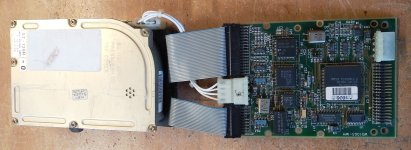mikerofone
Experienced Member
Hi all,
I got a Compaq Portable II with a Miniscribe 8425 HDD. It's an MFM drive that has an MFM to IDE adapter board bolted to it's underside, labelled WD1001-IWH. The system HDD controller is IDE.
The drive seems to be fine mechanically, but seems to be unable to find tracks. Any read to the drive results in the drive going to track zero and then slowly stepping to the requested track three times (see first video in this album), before returning an error. Seeks work fine though. I tested all this using SpeedStor 6.0.3.
My feeling is that the drive needs a low-level format so it'll find its sectors again. However I don't know how to do that with a drive connected via IDE. The corresponding option in SpeedStor errors out immediately after failing the first attempted write, which makes sense as it's going through the IDE controller. Other LLF tools like sgatfmt4 or the one in the IBM Advanced Diagnostics disk fail in the same way described above.
I didn't find too much documentation on the WD1001-IWH, but it doesn't seem to come with its own LLF routine [1]. I've tried a couple of the common DEBUG addresses and as one would expect, none work.
Any ideas on how, or if even at all, I could trigger a low-level format through the WD1001-IWH adapter? I feel like LLF-ing the drive by directly connecting it (without the IDE bridge) to a real MFM controller might help, but I currently don't have the right components available to do so.
Thanks for any suggestions!
Cheers
mikerofone
[1] https://www.os2museum.com/wp/learn-something-old-every-day-part-ii/ says it's similar to a WD1003-WAH which doesn't have an LLF tool either, as per https://minuszerodegrees.net/manual...d WD1003-WAH and WD1003-WA2 - Users Guide.pdf
I got a Compaq Portable II with a Miniscribe 8425 HDD. It's an MFM drive that has an MFM to IDE adapter board bolted to it's underside, labelled WD1001-IWH. The system HDD controller is IDE.
The drive seems to be fine mechanically, but seems to be unable to find tracks. Any read to the drive results in the drive going to track zero and then slowly stepping to the requested track three times (see first video in this album), before returning an error. Seeks work fine though. I tested all this using SpeedStor 6.0.3.
My feeling is that the drive needs a low-level format so it'll find its sectors again. However I don't know how to do that with a drive connected via IDE. The corresponding option in SpeedStor errors out immediately after failing the first attempted write, which makes sense as it's going through the IDE controller. Other LLF tools like sgatfmt4 or the one in the IBM Advanced Diagnostics disk fail in the same way described above.
I didn't find too much documentation on the WD1001-IWH, but it doesn't seem to come with its own LLF routine [1]. I've tried a couple of the common DEBUG addresses and as one would expect, none work.
Any ideas on how, or if even at all, I could trigger a low-level format through the WD1001-IWH adapter? I feel like LLF-ing the drive by directly connecting it (without the IDE bridge) to a real MFM controller might help, but I currently don't have the right components available to do so.
Thanks for any suggestions!
Cheers
mikerofone
[1] https://www.os2museum.com/wp/learn-something-old-every-day-part-ii/ says it's similar to a WD1003-WAH which doesn't have an LLF tool either, as per https://minuszerodegrees.net/manual...d WD1003-WAH and WD1003-WA2 - Users Guide.pdf

